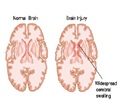
Eminent experts have contributed a series of insightful reviews.
Randall D. Buzan, Jeff Kupfer, Dixie Eastridge, and Andres Lema-Hincapie note that accepting post-injury personality changes is complicated by tacit assumptions about the nature of personality, free will, and the relationship between the mind and the brain. They challenge the Western Dualistic model of mind and body by reviewing the constructional nature of perception and the neurologic bases of affect, morality, empathy, and sense of self, and propose embodiment theory as one viable solution to the mind body dilemma.
Hal S. Wortzel and David B. Arciniegas draw attention to the substantial changes in the latest edition of the Diagnostic and Statistical Manual of Mental Disorders (DSM-5). Diagnosis is now based retrospectively on the severity of posttraumatic cognitive impairments and their effects on everyday function, as compared to the initial severity of TBI. They conclude that this approach is likely to improve the evaluations of persons with TBI by mental health professionals, including differential diagnosis.
TBI initiates a cascade of neuromodulatory damage that blurs distinctions between physical and psychological medicine, say Nadia E. Webb, Brittany Little, Stephanie Loupee-Wilson, and Elizabeth M. Power. They point out that monitoring endocrine function is critical to avoid misdiagnosing and mistreating clinical symptoms such as depression, fatigue, diminished concentration, irritability, and overall cognitive decline. Wider adoption of consensus guidelines on the detection and monitoring of endocrine abnormalities post-TBI may diminish the severity of functional impairment and improve quality of life.
Ryan McQueen and Gregory J. O'Shanick note that acute rehabilitation following neurotrauma has evolved over the past 30 years to include the common use of drugs to promote synaptogenesis and improve recovery potential. However, little guidance exists for similar strategies in post-acute or community re-entry phases ABI. They draw on the existing scientific literature, models of pharmacologic intervention in promoting stability in other disease states, and their own collective clinical experience to provide a potential structure to create a stable physiologic platform to facilitate proactive behavioral intervention.
Advertisement
Robert L. Karol provides perspectives on team models, in particular the advantages of transdisciplinary teams compared to multi- or interdisciplinary approaches in neurorehabilitation treatment. The paper highlights the roles that team members play in the different team models and associated effects on care coordination and outcomes. They explore concepts such as role release; letting other disciplines practice in one's own traditional arena; and expanded scope of practice. Crucial issues in the implementation of transdisciplinary teams include staff selection, rounds attendance, physical plant, peer pressure, and culture change.
Advertisement
Howard F. Jackson, Gemma Hague, Leanne Daniels, Ralph Aguilar Jr., Darren Carr, and William Kenyon explore key elements of structure in post-acute brain injury rehabilitation that can promote greater levels of personal functioning, emotional and behavioral stability, and independence. Through careful clinical management and integration of environmental factors, therapeutic alliances, organizational structures, and rehabilitation practices, many people with neurobehavioral challenges can transition from externally supported programmatic structures to processes of "self-structuring" that promote greater independence and quality of life.
In a follow-up article, Howard F. Jackson, Victoria Tunstall, Gemma Hague, Leanne Daniels, Stacey Crompton, and Kimberly Taplin report preliminary results using the Behavioral Assessment of Self-Structuring (BASS) staff rating scale, a standardized instrument to assess self-structuring. Initial results indicate that the BASS has reasonably good reliability, good construct validity, good discriminant validity, good concurrent validity, and sensitivity to change.
Timothy J. Feeney and Jason Achilich demonstrate the use of multi-component behavioral interventions to address challenging behaviors within natural settings. The two reported interventions extend the findings of previously published data for the effective treatment of behavioral challenges using a flexible support-oriented intervention that combines behavioral, cognitive, and executive function components. They controversially identify such people as "Chronically Cranky" to reflect how others often view such individuals, which in turn can affect treatment considerations unless one considers a holistic perspective of each situation.
Source-Eurekalert













